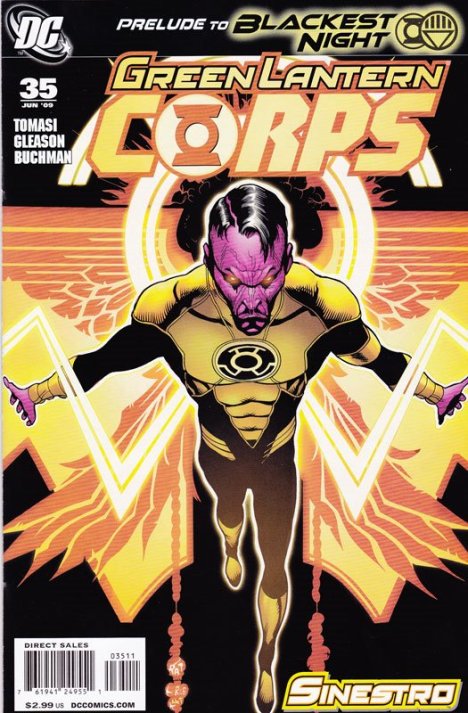
After a full day of panels I returned to whence I began, Empire Stage, for another big one, this time presented by the distinguished competition.
Gone were the charming advertisements – apparently someone thought better of them – and now we simply waited, glancing occasionally to the silent screen which informed us that we were sitting in DC Comics – Batman.
John Cunningham, a DC marketing VP, took the podium and introduced us to our guests. At the far left of the table was the beloved creative team behind DC’s relaunched Batman, Scott Snyder and Greg Capullo. Beside them was James Tynion IV, who writes Talon and Red Hood and the Outlaws. Next came Marc Andreyko, the controversially incoming writer on Batwoman. Beyond him was Kyle Higgins, who writes Nightwing, and Ann Nocenti, who pens Selina Kyle’s adventures in Catwoman. On the far end were John Layman, the surprisingly mild-mannered-looking man behind the current run of Detective Comics, and Peter Tomasi, writer for Batman and Robin.
As in nearly all things DC, this was largely Snyder’s show. Cunningham gave Snyder every opportunity to discuss last week’s Batman #24 (review here), but Snyder, in classic form, really just wanted to talk about how honored he was.
Snyder opened with a heartfelt thank you to the fans for not only letting him tell his stories, but supporting him in doing so. He waged charming, unassuming war on the notion that he did not respect the power and responsibility given to him in writing Batman’s origin story. Snyder called “Zero Year” his favorite story ever and seemingly could not help but show off some of the tricks that he brought to the table. Though he’s never been shy about it and his writing reeks of love for the character, Snyder put his status as a massive Batman fan on full display for this panel.
Continue reading
Filed under: Uncategorized | Tagged: Ann Nocenti, Batman, Batman and Robin, Batman: Eternal, Batwoman, Catwoman, Detective Comics, Greg Capullo, James Tynion IV, John Layman, Kyle Higgins, Marc Andreyko, New York Comic Con, Nightwing, NYCC 2013, Peter Tomasi, Red Hood and the Outlaws, Scott Snyder, Stephanie Brown, Talon, Zero Year | Leave a comment »








 By Peter Tomasi (writer), Ardian Syaf (pencils), John Dell, Vicente Cifuentes (inks), and Neil Ruffino (colorist)
By Peter Tomasi (writer), Ardian Syaf (pencils), John Dell, Vicente Cifuentes (inks), and Neil Ruffino (colorist)









 I’ve been reading the Justice Society of America hardcover trades as they’ve been released so I’m not really up to speed with what’s been going on. Those books are just beginning to scratch the surface of the whole Kingdom Come epic, so I had hopes that I wouldn’t be completely lost with Magog’s storyline here.
I’ve been reading the Justice Society of America hardcover trades as they’ve been released so I’m not really up to speed with what’s been going on. Those books are just beginning to scratch the surface of the whole Kingdom Come epic, so I had hopes that I wouldn’t be completely lost with Magog’s storyline here. The Story: In part two of the “Sins of the Star Sapphire” story, an envoy of Guardians journeys to the planet Zamaron to convince Queen Aga’po to stop harnessing the violet light, fearing further proliferation of the emotional light spectrum will advance the “Blackest Night” prophecy that they are struggling to prevent. As diplomatic tensions between the Guardians and Queen Aga’po grow strained, the Lanterns are horrified to discover that the Zamorans have been trying to rehabilitate captured Sinestro Corps members by brainwashing them with love.
The Story: In part two of the “Sins of the Star Sapphire” story, an envoy of Guardians journeys to the planet Zamaron to convince Queen Aga’po to stop harnessing the violet light, fearing further proliferation of the emotional light spectrum will advance the “Blackest Night” prophecy that they are struggling to prevent. As diplomatic tensions between the Guardians and Queen Aga’po grow strained, the Lanterns are horrified to discover that the Zamorans have been trying to rehabilitate captured Sinestro Corps members by brainwashing them with love. I thought this book was going to be just a bunch of heroes crying over Martian Manhunter. And we get a bit of that in the opening pages, but from there it goes into eulogy about J’onn J’onzz’s life, giving lots of little nuggets and highlights along the way. To be honest, I didn’t know too much about the character, so this stuff was most welcomed. Some fans who already know this stuff may find this retread a bit boring, especially at a steep $3.99 cover price.
I thought this book was going to be just a bunch of heroes crying over Martian Manhunter. And we get a bit of that in the opening pages, but from there it goes into eulogy about J’onn J’onzz’s life, giving lots of little nuggets and highlights along the way. To be honest, I didn’t know too much about the character, so this stuff was most welcomed. Some fans who already know this stuff may find this retread a bit boring, especially at a steep $3.99 cover price.